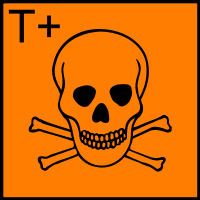NAMES AND DATABASE IDS
NAMES AND DATABASE IDS
Names Database IDs
|
IUPAC name
|
|
|
IUPAC Traditional name
|
|
|
Synonyms
|
|
trifluorotriazine
|
|
2,4,6-trifluoro-s-triazine
|
|
cyanuryl fluoride
|
|
Cyanuric fluoride
|
|
2,4,6-Trifluoro-1,3,5-triazine
|
|
Cyanuric fluoride
|
|
2,4,6-三氟-1,3,5-三嗪
|
|
三聚氟氰
|
|
|
|
|
CAS Number
|
|
|
EC Number
|
|
|
MDL Number
|
|
|
Beilstein Number
|
|
|
PubChem SID
|
|
|
PubChem CID
|
|
|
Chemspider ID
|
|
|
Wikipedia Title
|
|
DATA SOURCES
DATA SOURCES
All Sources Commercial Sources Non-commercial Sources
CALCULATED PROPERTIES
CALCULATED PROPERTIES
JChem
|
H Acceptors
|
3
|
H Donor
|
0
|
LogD (pH = 5.5)
|
1.7186153
|
LogD (pH = 7.4)
|
1.7186153
|
Log P
|
1.7186153
|
Molar Refractivity
|
25.1124 cm3
|
Polarizability
|
7.5072546 Å3
|
Polar Surface Area
|
38.67 Å2
|
Rotatable Bonds
|
0
|
Lipinski's Rule of Five
|
true
|
PROPERTIES
PROPERTIES
Physical Property
Safety Information
Product Information
Bioassay(PubChem)
|
Apperance
|
|
colourless liquid
|
 Show
data source Show
data source
|
|
|
Melting Point
|
|
−38 °C
|
 Show
data source Show
data source
|
|
-38°C
|
 Show
data source Show
data source
|
|
|
Boiling Point
|
|
73-74°C
|
 Show
data source Show
data source
|
|
74 °C
|
 Show
data source Show
data source
|
|
|
Density
|
|
1.574
|
 Show
data source Show
data source
|
|
1.574 g/cm3
|
 Show
data source Show
data source
|
|
|
Refractive Index
|
|
1.3840
|
 Show
data source Show
data source
|
|
|
Storage Warning
|
|
Moisture Sensitive
|
 Show
data source Show
data source
|
|
|
RTECS
|
|
XZ1750000
|
 Show
data source Show
data source
|
|
|
European Hazard Symbols
|
 Corrosive (C) Corrosive (C)
|
 Show
data source Show
data source
|
 Highly toxic (T+) Highly toxic (T+)
|
 Show
data source Show
data source
|
|
|
UN Number
|
|
3389
|
 Show
data source Show
data source
|
|
UN3389
|
 Show
data source Show
data source
|
|
|
MSDS Link
|
|
|
German water hazard class
|
|
3
|
 Show
data source Show
data source
|
|
|
Hazard Class
|
|
6.1
|
 Show
data source Show
data source
|
|
|
Packing Group
|
|
1
|
 Show
data source Show
data source
|
|
I
|
 Show
data source Show
data source
|
|
|
Risk Statements
|
|
24-26-35
|
 Show
data source Show
data source
|
|
R24, R26, R35
|
 Show
data source Show
data source
|
|
|
Safety Statements
|
|
20-26-27/28-36/37/39-45
|
 Show
data source Show
data source
|
|
26-28-36/37/39-45
|
 Show
data source Show
data source
|
|
S26, S28, S36/37/39, S45
|
 Show
data source Show
data source
|
|
|
TSCA Listed
|
|
是
|
 Show
data source Show
data source
|
|
|
GHS Pictograms
|

|
 Show
data source Show
data source
|

|
 Show
data source Show
data source
|
|
|
GHS Signal Word
|
|
Danger
|
 Show
data source Show
data source
|
|
|
GHS Hazard statements
|
|
H310-H314-H330
|
 Show
data source Show
data source
|
|
H310-H330-H314-H318
|
 Show
data source Show
data source
|
|
|
GHS Precautionary statements
|
|
P260-P280-P284-P302 + P350-P305 + P351 + P338-P310
|
 Show
data source Show
data source
|
|
P260-P303+P361+P353-P304+P340-P305+P351+P338-P320-P361-P405-P501A
|
 Show
data source Show
data source
|
|
|
Personal Protective Equipment
|
|
Faceshields, full-face respirator (US), Gloves, Goggles, multi-purpose combination respirator cartridge (US), type ABEK (EN14387) respirator filter
|
 Show
data source Show
data source
|
|
|
RID/ADR
|
|
UN 3389 6.1/PG 1
|
 Show
data source Show
data source
|
|
|
Purity
|
|
≥97.0% (GC)
|
 Show
data source Show
data source
|
|
98%
|
 Show
data source Show
data source
|
|
|
Empirical Formula (Hill Notation)
|
|
C3F3N3
|
 Show
data source Show
data source
|
|
DETAILS
DETAILS
 Wikipedia
Wikipedia
 Sigma Aldrich
Sigma Aldrich
Sigma Aldrich -
28625

|
Caution
can precipitate on storage
Other Notes
Modifies tyrosyl residues in proteins1,2; Reagent used for the preparation of carboxylic fluorides3,4
Packaging
10, 50 g in glass bottle |
REFERENCES
REFERENCES
From Suppliers
 Google Scholar
Google Scholar

 PubMed
PubMed

 Google Books
Google Books

- • In combination with pyridine, converts carboxylic acids to acyl fluorides in high yields under mild conditions: Synthesis, 487 (1973). Similarly, protected (Fmoc) amino acids are converted in dichloromethane solution to amino acid fluorides. tert-Butyl ester and ether groups are also stable under these conditions. The resulting acyl fluorides are more stable to water than the corresponding acyl chlorides but are more reactive to amines, thus providing a useful peptide coupling method: J. Am. Chem. Soc., 112, 9651 (1990); Tetrahedron, 50, 5309 (1994); Appendix 6. For use of Fmoc amino acid fluorides in solid-phase peptide synthesis, see: Tetrahedron Lett., 32, 1303 (1991); J. Org. Chem., 59, 3275 (1994). For a review of peptide synthesis via amino acid halides, see: Acc. Chem. Res., 29, 268 (1996).
- • Carboxylic acids can be converted to alcohols under mild conditions via the acyl fluoride and reduction with NaBH4 in the presence of MeOH. The method can be carried out in one pot and is applicable to N-protected amino acids and peptides for which other reduction methods are unsuitable: J. Org. Chem., 61, 6994 (1996).
- • Reagent for deoxygenation of alkyl sulfoxides, cf Cyanuric chloride, L03442: Synthesis, 221 (1980), and for dehydration, at room temperature in DMF, of Boc amino acid amides to nitriles: Tetrahedron. Lett., 38, 4221 (1997).
- Searching...Please wait...
PATENTS
PATENTS
 PubChem Patent
PubChem Patent
 Google Patent
Google Patent
